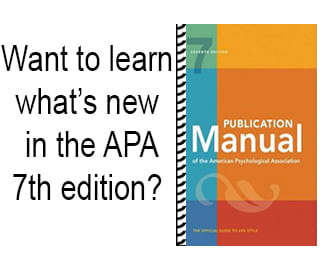

Academic writer Quick guide: Reference elements
Guide to learning about reference elements for reference page
A Quick Guide to APA Citation 7th Edition


![]()
When formatting the author element of a citation you should follow these guidelines:
Insert the authors’ name, providing the surname first, followed by a comma and the author’s initials. Authors' first and middle names should be written as initials.
Use a comma to separate an author’s initials from other author names, even when there are only two authors. Use an ampersand (&) before the final author’s name. This will be done for any source that has up to 20 authors.
A source with 21 or more authors you should include just the first 19 authors’ names, insert an ellipsis (but no ampersand), and then add the final author’s name.
For sources that were created by a group such as an organization, Spell out the full name of the group in the position of the author element, followed by a period.
The date element of a citation is formatted in the following ways:
1. The date will have the following forms:
year only; year, month, and day; year and month; year and season; or range of dates.
2. Enclose the date of publication in parentheses, followed by a period
3. For sources that include the month, day, and/or season along with the year, put the year first, followed by a comma, and then the month and date or season.
4. Do not include a date of last review in a citation because content that has been reviewed has not necessarily been changed.
5. When a retrieval date is needed, use the following format for it:
Retrieved September 30, 2020, from https://xxxxx
When formatting the title element of a citation or reference, use the following steps:
The Title of a source can fall into two main categories: A source that can stand alone or a source within a bigger source
When a work stands alone, the title of that work appears in the title element of the reference.
When a work is part of a greater whole, the title of the article or chapter appears in the title element of the reference and the bigger source's title appears in the source element position.
When it comes to capitalization of a title, there are two formats:
Sentence Case: most major and minor words are lowercase except proper nouns
Title Case: major words are capitalized, and most minor words are lowercase
When formatting the source of an element follow these guidelines:
Use the following table created by APAstyle.org as a guide for formatting the source element:
|
Reference type |
Components of the source |
Example source element |
|---|---|---|
|
Journal article |
Periodical title, volume, issue, page range, and DOI or URL |
Couple and Family Psychology: Research and Practice, 8(3), 137–151. https://doi.org/10.1037/cfp0000121 |
|
Journal article with article number |
Periodical title, volume, issue, article number, and DOI or URL |
PLoS ONE, 14(9), Article e0222224. https://doi.org/10.1371/journal.pone.0222224 |
|
Authored book or whole edited book |
Publisher name and DOI or URL |
|
|
Edited book chapter |
Information about the whole book (including editor name, book title, edition and/or volume number, page range, and publisher name) and DOI or URL |
In G. R. Samanez-Larkin (Ed.), The aging brain: Functional adaptation across adulthood (pp. 9–43). American Psychological Association. https://doi.org/10.1037/0000143-002 |
|
Webpage on a website (when authors are different from the site name) |
Website name and URL |
Mayo Clinic. https://www.mayoclinic.org/drugs-supplements-acidophilus/art-20361967 |
|
Webpage on a website (when authors are the same as the site name) |
URL |